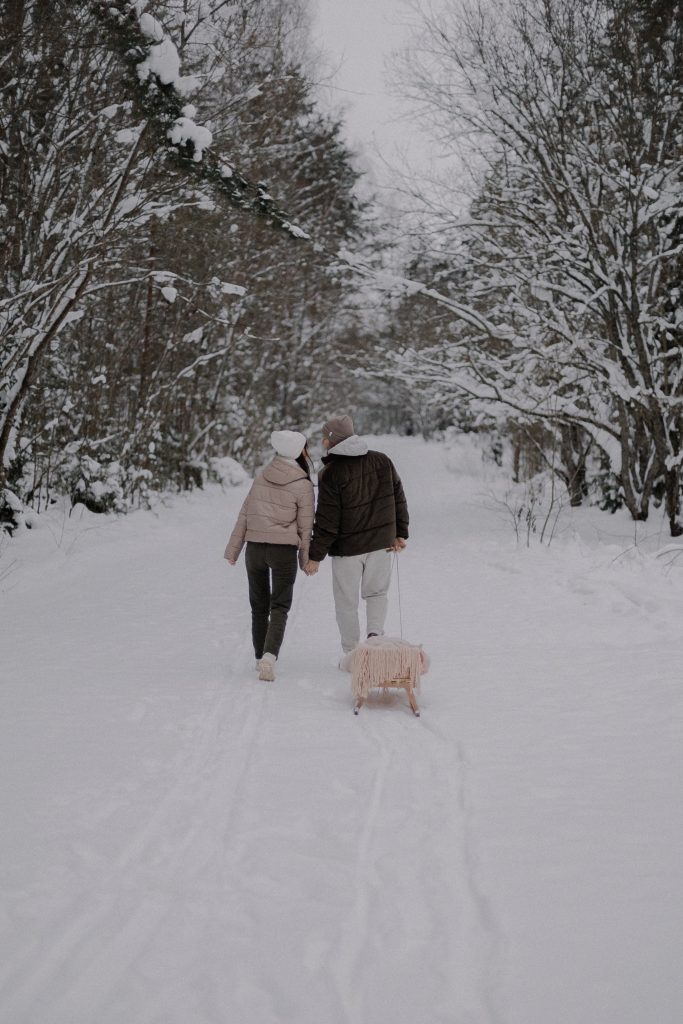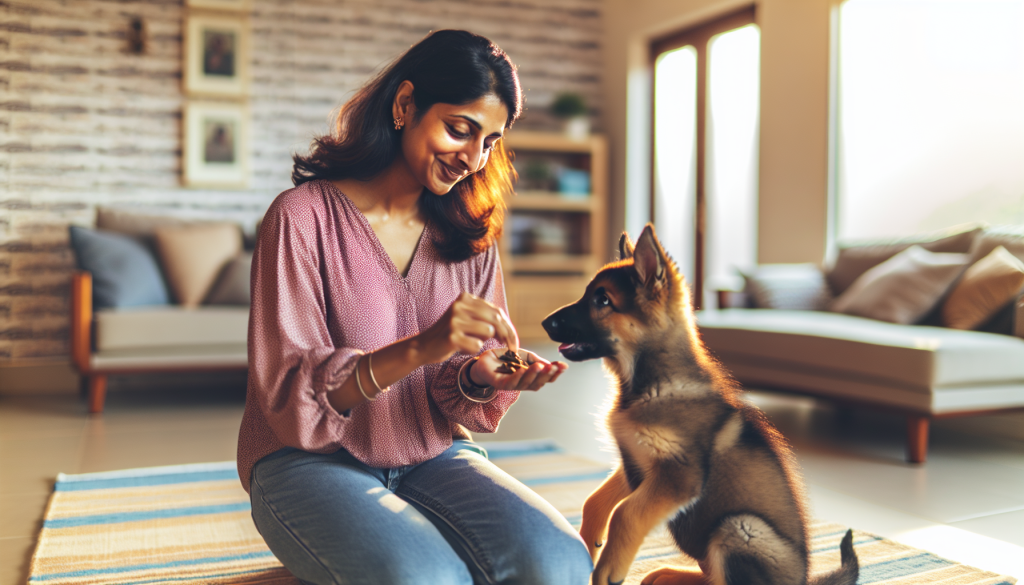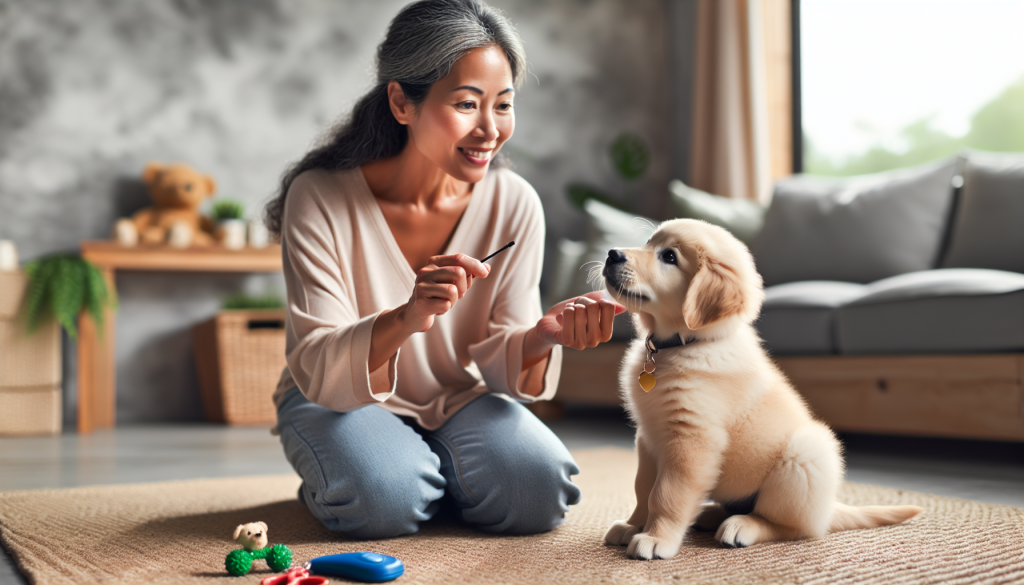So you’ve brought home a fluffy little bundle of joy and now you’re wondering when to begin training your new puppy. Well, the answer is simpler than you might think. It’s never too early to start teaching your furry friend some basic obedience skills and good manners. From the moment they step paws into your home, puppies are ready and eager to learn. By introducing consistent routines and positive reinforcement techniques, you can start setting the foundation for a well-behaved and happy companion. Whether it’s mastering simple commands like sit and stay or getting them used to everyday household noises, the earlier you start training, the better the results.
General Guidelines
Critical Period of Socialization
During the critical period of socialization, which typically occurs between 3 and 14 weeks of age, it is crucial to expose your puppy to a wide variety of people, animals, and environments. This period is when puppies are most receptive to new experiences and can learn to feel comfortable and confident in different situations. By providing positive and controlled socialization experiences during this time, you can help your puppy develop into a well-rounded and adaptable adult dog.
Physical and Emotional Readiness
It is important to consider your puppy’s physical and emotional readiness before starting any training. Puppies need to have reached the appropriate developmental milestones and have the necessary physical abilities to effectively learn and participate in training exercises. Additionally, it is essential to assess your puppy’s emotional state and ensure they are calm and focused before beginning a training session. Training should never be forced or overwhelming for your puppy.
Attention Span and Focus
Puppies have short attention spans and can easily become distracted. It is important to keep training sessions short and engaging to prevent your puppy from becoming bored or frustrated. Start with brief sessions of around 5 to 10 minutes and gradually increase the duration as your puppy’s attention span improves. Use high-value treats and positive reinforcement to keep your puppy engaged and motivated during training.
Basic Commands
Sit
Teaching your puppy to sit is one of the first commands you should work on. Start by holding a treat close to your puppy’s nose, then slowly move it upwards and backwards, causing their head to follow the treat and their bottom to naturally lower into a sitting position. As soon as they are seated, say “sit” and give them the treat. Repeat this process several times until your puppy understands the command. Remember to reward and praise them each time they successfully sit.
Stay
The “stay” command is important for keeping your puppy in one place until given permission to move. Start by having your puppy sit in front of you. Hold your open palm towards them and say “stay” in a firm but friendly tone. Take a small step backward and if they remain in the sitting position, use a reward signal such as a clicker or a verbal cue like “good” and reward them with a treat. Gradually increase the distance and duration of the stay command over time, rewarding your puppy for their successful stays.
Lie Down
Teaching your puppy to lie down on command can be helpful in various situations, such as when you want them to relax or when you need them to stay in one place for an extended period. Start with your puppy in a sitting position. Hold a treat near their nose and slowly move it downwards towards the ground. As your puppy follows the treat with their nose, their body will naturally lower into a lying position. Once they are lying down, say “down” and reward them. Practice this command regularly to reinforce the behavior.
Come
The “come” command is vital for ensuring your puppy’s safety and controlling their behavior. Begin by getting down to your puppy’s level and using an excited and cheerful tone of voice. Say “come” while gently patting your thighs or using a treat as a lure. When your puppy comes to you, reward them with praise, affection, and a treat. Practice this command in a safe and controlled environment, gradually adding distractions and distance to reinforce their recall skills.
Leave It
Teaching your puppy the “leave it” command is essential for preventing them from picking up items they shouldn’t have or eating something harmful. Start by showing your puppy a treat in your closed hand. Allow them to sniff and nuzzle your hand, but do not open it. As soon as they stop trying to get the treat, say “leave it” and reward them with a different treat from your other hand. Repeat this process, gradually increasing the difficulty by placing treats on the ground or using more tempting items.
Drop It
The “drop it” command is useful for getting your puppy to release items they have picked up, whether it’s a toy, a sock, or something potentially dangerous. Begin by offering your puppy a toy or object they enjoy playing with. Once they have it in their mouth, show them a high-value treat and say “drop it” in a gentle but firm tone. When your puppy releases the object, reward them with the treat and praise. Practice this command regularly with different items to reinforce their understanding and compliance.

This image is property of images.pexels.com.
Housebreaking
Establishing a Routine
Establishing a consistent routine is crucial for successfully housebreaking your puppy. Designate specific areas where your puppy is allowed to eliminate, and take them to these spots consistently and at regular intervals throughout the day. Create a feeding schedule to predict when your puppy will need to go outside and always take them out after meals, playtime, or waking up from a nap. By following a routine, you can help your puppy develop good bathroom habits and minimize accidents indoors.
Positive Reinforcement
Positive reinforcement is key to encouraging your puppy to eliminate outside. Whenever your puppy goes to the designated elimination spot and successfully eliminates, immediately reward them with praise, affection, and a small treat. Use a consistent cue word or phrase, such as “go potty” or “do your business,” to associate the act of elimination with the designated spot. Positive reinforcement helps your puppy understand that eliminating outside is highly desirable and will increase the likelihood of them repeating the behavior.
Consistency and Patience
Housebreaking takes time and patience. Your puppy will have accidents, and it’s important not to scold or punish them. Instead, focus on teaching them the appropriate behavior and offering positive reinforcement when they eliminate outside. Consistency is crucial – stick to the routine, provide ample opportunities for your puppy to go outside, and monitor their behavior closely. With time, patience, and consistency, your puppy will learn where and when to eliminate.
Crate Training
Crate training can be a valuable tool in the housebreaking process. A properly introduced and appropriately sized crate can serve as a den for your puppy, providing them with a safe and comfortable space. Dogs have a natural instinct to keep their sleeping area clean, so utilizing a crate can help prevent accidents indoors. Gradually introduce your puppy to the crate by making it a positive and rewarding experience. Use treats, praise, and toys to create a positive association and gradually increase the duration of time your puppy spends in the crate. Always ensure the crate is large enough for your puppy to stand, turn around, and lie down comfortably.
Leash Training
Introducing the Leash
When introducing your puppy to a leash, start by placing it on the ground and letting your puppy investigate it without any tension. Gradually pick up the leash and let it trail behind your puppy as you walk together. Reward your puppy with treats and praise for calm and relaxed behavior around the leash. Once your puppy is comfortable with the leash, attach it to their collar or harness, again rewarding them for calm behavior. Remember to use a lightweight and comfortable leash appropriate for your puppy’s size and strength.
Positive Reinforcement
Positive reinforcement is crucial during leash training. Reward your puppy with treats and praise for walking calmly and staying by your side. If your puppy pulls on the leash, simply stop moving and wait for them to relax before resuming the walk. Avoid using punishment or forceful corrections, as they can create fear or resistance towards the leash. Focus on rewarding the behavior you want, rather than punishing undesirable behavior.
Teaching Loose Leash Walking
Teaching your puppy to walk on a loose leash is important for enjoyable and stress-free walks. Start by walking at a slow pace, encouraging your puppy to stay close to you using treats and positive reinforcement. If your puppy starts to pull, stop and wait for them to relax and release tension on the leash before continuing. Utilize changes in direction and turns to keep your puppy engaged and focused on you. Gradually increase the duration and distance of your walks, rewarding your puppy for maintaining a loose leash and walking calmly.
Addressing Pulling and Lunging
If your puppy tends to pull or lunge on the leash, it is important to address this behavior early on. Do not continue walking while your puppy is pulling, as this will only reinforce the behavior. Instead, stop, and wait for your puppy to relax and release tension on the leash before moving forward. Alternatively, change direction frequently to redirect your puppy’s attention back to you. Consider using a front-clip harness to discourage pulling, as it can gently guide your puppy back towards you when they start to pull.

This image is property of images.pexels.com.
Socialization
Early Socialization
Early socialization is crucial for a well-rounded and balanced adult dog. Socialize your puppy from an early age by exposing them to a wide variety of people, animals, and environments. Introduce your puppy to different sights, sounds, smells, and surfaces to help them become confident and adaptable. Positive experiences during the socialization period can help prevent fear and aggression later in life. It is important to continue socializing your puppy throughout their entire life to maintain their social skills and prevent behavioral issues.
Positive Experiences
When socializing your puppy, focus on creating positive experiences. Gradually introduce them to new people, animals, and environments, and reward them for calm and appropriate behavior. Use treats and praise to reinforce positive experiences, and avoid forcing your puppy into overwhelming situations. Always monitor your puppy’s body language and provide them with breaks or space if they show signs of fear or stress.
Meeting Other Dogs
Allowing your puppy to interact with other dogs is an important part of socialization. Start with controlled and supervised playdates with well-behaved and vaccinated dogs. Ensure the interactions are positive and monitored closely for any signs of aggression. Gradually increase the complexity of the interactions, exposing your puppy to different sizes, breeds, and energy levels of dogs. Remember that not all dogs may be suitable playmates, so always prioritize your puppy’s safety and well-being.
Meeting Different People
Exposing your puppy to different types of people is crucial for their social development. Introduce them to people of different ages, genders, races, and appearances. Encourage strangers to offer treats or engage in gentle play to create positive associations. Gradually expose your puppy to different environments and situations, such as crowded areas, loud noises, and various household objects. This will help your puppy become comfortable and confident in different social settings.
Behavioral Issues
Biting and Nipping
Biting and nipping are common behaviors in puppies, but it’s important to address them early on to prevent them from developing into more serious problems. When your puppy starts to nibble or bite, redirect their attention to an appropriate chew toy or bone. Remove yourself from the situation if necessary, as puppies learn to control their bite pressure through feedback from their littermates. Consistency, positive reinforcement, and providing appropriate outlets for chewing are key in teaching your puppy bite inhibition.
Chewing
Puppies have a natural urge to chew, and it is important to provide them with appropriate outlets for this behavior. Offer a variety of chew toys, bones, and puzzle toys to keep your puppy engaged and redirect their chewing instincts away from your belongings. Reward your puppy when they choose to chew on appropriate items. Additionally, ensure your puppy has ample exercise and mental stimulation to prevent excessive chewing out of boredom or frustration.
Jumping
While it may be cute when a small puppy jumps up to greet you, it’s crucial to discourage this behavior as they grow. To discourage jumping, turn away from your puppy and avoid eye contact or verbal interaction when they try to jump. Only give attention and affection when all four paws are on the ground. Teach your puppy alternative behaviors, such as sitting, to receive attention instead. Consistency and positive reinforcement will help your puppy understand that jumping is not acceptable.
Excessive Barking
Addressing excessive barking requires identifying the underlying cause of the behavior. Possible reasons for excessive barking include boredom, anxiety, fear, or a desire for attention. Provide your puppy with ample physical and mental exercise to help alleviate boredom. Gradually desensitize your puppy to triggers that elicit barking, such as unfamiliar noises or visitors. Reward calm and quiet behavior and consider seeking guidance from a professional trainer if excessive barking persists.
Separation Anxiety
Separation anxiety can be a challenging behavior to address and may require professional guidance. Gradually desensitize your puppy to being alone by starting with short absences and gradually increasing the duration over time. Provide mental stimulation and interactive toys to keep your puppy occupied while you are away. Consider using calming aids, such as puzzle toys or pheromone diffusers, to help alleviate anxiety. Consult with a professional trainer or behaviorist for specific strategies to address separation anxiety.

This image is property of images.pexels.com.
Obedience Training
Building a Strong Foundation
Building a strong foundation for obedience training is essential for maintaining a well-behaved and responsive dog. Start with the basic commands, such as sit, stay, lie down, and come, and gradually increase the difficulty and complexity of the exercises. Use positive reinforcement, consistency, and clear communication to set clear expectations for your puppy. Focus on building a strong bond and trust with your puppy through training and reinforcement.
Positive Reinforcement
Positive reinforcement is the most effective and humane method of training. Reward your puppy with treats, praise, and affection for performing desired behaviors. Use a marker, such as a clicker or a verbal cue like “yes,” to mark the desired behavior and immediately follow it with a reward. This positive association will strengthen the connection between the command and the reward, making training more successful and enjoyable for both you and your puppy.
Clicker Training
Clicker training is a popular method of training that utilizes a handheld device that makes a distinct clicking sound. The clicker serves as a marker to indicate the desired behavior, allowing for precise timing and clear communication. Clicker training can be used to shape and reinforce a wide range of behaviors, from basic commands to complex tricks. As with any training method, consistency, patience, and positive reinforcement are key to successful clicker training.
Consistency and Repetition
Consistency and repetition are essential in obedience training. Dogs thrive on routine and clear expectations. Use the same verbal cues and hand signals consistently to help your puppy understand and respond to commands. Practice regularly and in different environments to generalize the learned behaviors. Gradually increase distractions and difficulty over time to ensure your puppy can perform commands in various real-life situations.
Socializing with Other Animals
Gradual Introductions
Introducing your puppy to other animals should be done gradually and in a controlled environment. Start by allowing your puppy to observe the other animal from a distance, gradually decreasing the distance over time. Reward your puppy for calm and relaxed behavior during the introductions. Consider using a barrier or gate to maintain physical separation initially, allowing the animals to become familiar with each other’s scents and presence before direct interaction.
Supervised Interactions
Supervision is crucial during interactions between your puppy and other animals. Observe their body language and intervene if necessary to prevent any negative or aggressive behaviors. Reward positive interactions and separate the animals if play becomes too rough or one animal becomes overly dominant. Gradually increase the duration and frequency of the interactions as both animals become more comfortable and familiar with each other.
Positive Reinforcement
Use positive reinforcement to reward your puppy for appropriate behavior during interactions with other animals. Reward calm and friendly behavior, and redirect or distract your puppy if they show signs of fear or aggression. Ensure each interaction ends on a positive note and create a positive association between the presence of other animals and rewarding experiences. Patience and consistency are key as your puppy learns to socialize and interact appropriately with other animals.
Addressing Aggression or Fear
If your puppy displays aggression or fear towards other animals, it is important to address these behaviors promptly and seek professional guidance if needed. Avoid forcing interactions that make your puppy uncomfortable and ensure their safety. Consult with a professional trainer or behaviorist to develop a behavior modification plan to address aggression or fear. With proper guidance and positive reinforcement, many puppies can learn to overcome these issues and develop positive relationships with other animals.

Advanced Training
Stay
Building on the basic “stay” command, advanced stay training involves increasing the duration and distance of the stay. Ensure your puppy understands the basic stay command before gradually increasing the difficulty. Start by taking a step back, then gradually increase the distance between you and your puppy. Use a release cue, such as “okay” or “free,” to indicate the end of the stay. Remember to reward and reinforce each successful stay with praise and treats.
Wait
The “wait” command is useful for teaching your puppy to pause or hold still before proceeding. It can be used in various situations, such as waiting for you to open a door or allowing you to cross the street first. Start by asking your puppy to sit or stand, then present your hand in a stop signal and say “wait.” Take a step forward, and if your puppy remains in the desired position, reward them with praise and a treat. Gradually increase the duration of the wait command over time.
Heel
The “heel” command teaches your puppy to walk calmly and closely by your side. Start with your puppy on your preferred side, holding the leash with a loose grip. Begin walking, using treats and positive reinforcement to reward your puppy for walking by your side. If your puppy starts to pull or stray, use a verbal cue like “heel” and gently guide them back into position. Practice this command in different environments with increasing distractions, rewarding your puppy for maintaining the proper position.
Fetch
Teaching your puppy to fetch is not only a fun game but also a useful command for mental and physical stimulation. Start by introducing a favorite toy and encourage your puppy to interact with it. When your puppy shows interest, throw the toy a short distance and say “fetch.” As your puppy retrieves the toy, reward them with praise and a treat. Gradually increase the distance of the throws and reinforce the command. With practice and positive reinforcement, your puppy can learn to retrieve and return the toy on command.
Off-Leash Training
Off-leash training should only be attempted in safe and secure environments, such as fenced-in areas or designated off-leash dog parks. Begin by reinforcing basic obedience commands in an enclosed space, gradually increasing the distance between you and your puppy. Use a long training leash for added control and safety. Practice recall exercises regularly, rewarding your puppy for coming back to you. Remember to prioritize your puppy’s safety and be cautious when allowing off-leash freedom in unfamiliar or potentially dangerous environments.
Professional Training
Considering a Professional Trainer
If you are struggling with training your puppy or facing behavior challenges that you cannot address on your own, it may be beneficial to seek the guidance of a professional trainer or behaviorist. Professional trainers have experience in working with puppies and can provide expert advice tailored to your specific needs. They can help you develop a personalized training plan, address any behavioral issues, and guide you in establishing a strong bond and effective communication with your puppy.
Puppy Training Classes
Puppy training classes are an excellent option for socialization and training. These classes provide a structured and supervised environment for puppies to socialize, learn basic commands, and develop good manners. Trained instructors can offer guidance and support throughout the training process, ensuring consistency and helping you navigate any challenges. In addition to training, these classes also offer an opportunity for puppies to interact with other puppies, helping them develop valuable social skills.
In-Home Training
In-home training is a convenient option for those who prefer personalized and one-on-one attention for their puppy. Professional trainers can come to your home and address specific training needs and behavioral issues in a familiar environment. In-home training can be particularly beneficial for addressing issues such as housebreaking, separation anxiety, or territorial behavior. Trainers can provide customized solutions and work directly with you and your puppy to achieve desired results.
Benefits of Professional Guidance
Seeking professional guidance for training your puppy offers several benefits. Professional trainers have the knowledge and experience to provide effective training techniques and address behavioral issues. They can assess your puppy’s individual needs and develop a customized training plan. Professional trainers also provide accountability and support, helping you stay consistent and motivated throughout the training process. With their guidance, you can build a strong foundation of obedience, address behavioral challenges, and ensure a positive and fulfilling relationship with your puppy.
